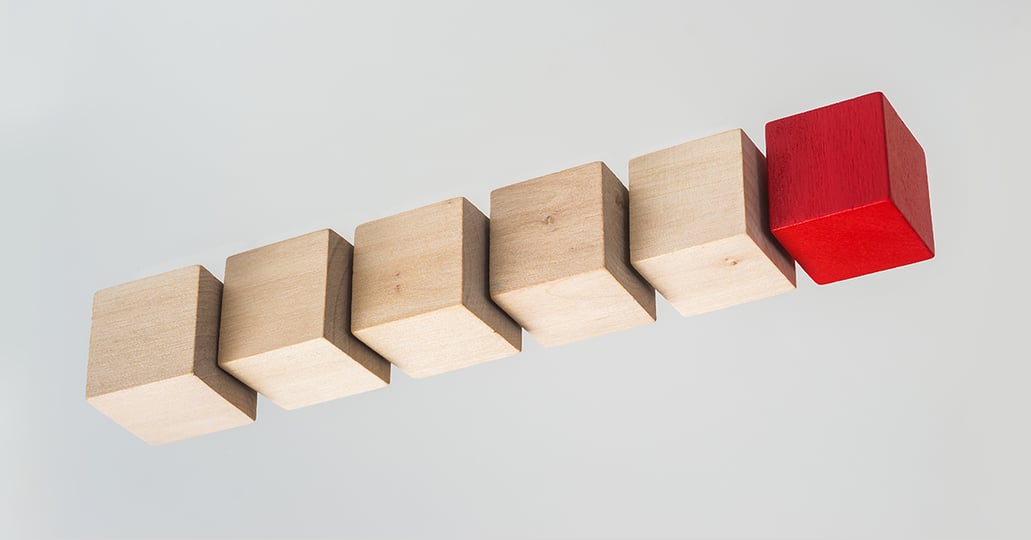- Blog Overview
- Knowledge
- What is linear queuing?

What is linear queuing?
Mark Sarria |December 4 2019 | 10 min
In this blog post we’ll discuss the oldest and most common way to manage queues and waiting – Linear Queuing. But what does it exactly stand for, and how does it differentiate compared to other types of queuing principles? Learn all about the important factors when designing a linear queue, the benefits, and when it is the most suitable to use.
Do you remember the last time when you stood in a line, asking yourself, “Did I manage to pick the right line after all?” Contemplating to switch to another line that seems to be moving faster, feeling more uncertain as time passes by. And then it happens - the person that arrived after you is now getting served. Now you find yourself irritated, trying to calm yourself down with the words of a famous psychologist you heard on TV, who said that stressful situations are a perfect opportunity to practice mindfulness. Well, you’re not alone, we’ve all been there. Therefore, we thought that you might want to know the differences when it comes to queuing, as it might help you to pick the right line next time. Or at least explain what type of line you are standing in.
Linear queuing – the oldest and most common queue
The oldest and most common way to manage queues and waiting is through linear queuing, which means that the customer waits physically in a queue. In a linear queue the time wasted between service is minimized, leading to a high throughput of customers and high productivity for the service provider. This is achieved as the next customer in the queue is ready to be served as soon as the member of staff finishes serving the prior customer. The high throughput of customers leads to short waiting times, assuming that the service provider does not account for the full effect in productivity by reducing the number of staff.
When linear queuing is well managed, you as the service provider can benefit from operational efficiency, better use of floor space, a provide feeling of fairness among your customers and big savings in the cost of resources. Not to mention the fact that you effectively avoid chaotic scenes inside or outside your business, creating a greater perception with the best queue discipline and queue management solution.
Different variations of linear queuing
Linear queuing comes in different variations depending on the specific situation, objectives and circumstances, here are some examples.
First-In-First-Out (FIFO)
The standard queue type where a customer walks to the end of the queue and waits the entire length to be served is known as First-In-First-Out (FIFO). Here, the goal is to serve the customers in the order in which they arrived. This is appropriate to use in a single-counter environment as it requires minimum planning and layout considerations. The FIFO line is typically found in service centers with fewer customers, such as coffee shops and fast food restaurants. The issues that occurs in these types of lines is the phenomenon of customer Reneging (when people leave the line before being served) and Balking (when a person doesn’t join the queue at all). However, FIFO is general the best queue type to use in a single-counter environment as it requires minimum planning and less physical space than other types of queues.
Multiple parallel lines
The multiple parallel lines offer the possibility to segment customers based on service needs. Customers who require services with longer expected service times can be separated from those with faster requirements. This queuing discipline is better used for larger establishments and/or customer journeys rather than FIFO line, as it allows segmentation. However, it poses a customer service problem when customers choose “the wrong” queue and feel unfairly treated when people who arrived after you is getting served first. This can make people start switching from one line to another, a phenomenon known as Jockeying. Given the disadvantages of multiple queues in different situations, the serpentine line is gaining ground in these environments.
The serpentine line
The most fair and acceptable arrangement to customers is the serpentine line where the supply of service is distributed logically to the customer who queued first. A slow customer may affect delivery overall, but customers will always be directed to the first available counter/server. The advantages with this queue type are that there’s no uncertainty about which queue to join and no unfairness since first come first served is always true. Also, it’s the most effective queue type as the serpentine line reduces the average queue length, queue time, and wait probability in comparison to multiple parallel lines. However, as it may be easier to see the length of the queue, it seen as slow, which can be can discourage customers to stand in line at all, Also, other aspects concern the issue of balking, where people are more prone to leave a serpentine line rather than multiple lines. Since people think that the odds are greater of choosing the right line rather than standing in one line. Many businesses are switching to the serpentine line, which can be seen at banks, airports and fast food restaurants to mention a few.
Communicate with clarity
Although a well-managed and fair linear queue is in place, it’s equally important to communicate with clarity to keep customers aware of how long it will take and provide a comfortable environment that reduce uncertainty. With the use of Digital Signage products, businesses can eliminate the uncertainty and facilitate the customer journey. By communicating in a way that engages, informs, and integrates perfectly with the environment, customers will feel more welcome and informed, and it speeds up the serving process by calling people forward at the right time.
Move beyond linear queuing and discover Customer Journey Management
In the digital age, customers want to do business with companies in more ways than before – social, digital, direct, in-store, mobile, and call center. An often forgotten touchpoint is the transition from the virtual to the physical world. With Customer Journey Management you can bridge that gap by integrating the virtual and physical world to create seamless customer journeys. By allowing customers to book online, to utilize their smart devices to manage their place in the queue, to self-check-in, to receive personalized service based on preferences and profile and to provide their views in real-time Customer Journey Management makes sure that both our clients and their customers and patients make the most of every meeting.
Customer Journey Management consist of a range of systems built with modern software and hardware designed to work together, and provides vast opportunities to integrate to other systems like CRM, Point of Sale, Business Analytics, Digital Signage, Hospital Information Systems and Mobile apps supporting the objective of making the most of every meeting
By moving beyond the old fashioned way of queuing, you can now better understand customers’ journeys, which helps to gain a broader perspective of how customers engage, providing the insight and resources businesses need to succeed.
If you want to know more about what your business can achieve with a queue management system / customer journey management system, download the PowerPoint presentation below, were the following questions are addressed:
• What is a queue management system?
• How does a queue management system work?
• When to consider a queue management system?
• Which sectors benefit the most of queue management system?









